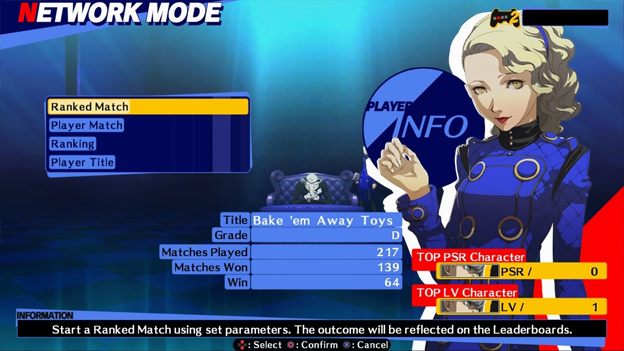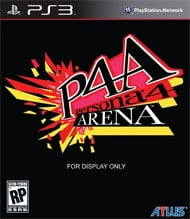A Fighting Game For RPG Gamers
Persona 4 Arena, the newest fighting game by Atlus and Arc System Works, is presented with an interesting challenge. As an ArcSys fighter, it has to appeal to the hardcore fighting game crowd that eats frame data, breathes combos, and sweats mind games. However, as a game in the Persona franchise, it has to appeal to RPG fans who may have never touched a fighting game in their lives. You’d think that pleasing both groups of fans would be mutually exclusive, but somehow Arc pulled it off, creating a truly unique fighting experience unlike anything we have seen before.
Persona 4’s gameplay system essentially lets you skip all the low-level fighting game basics that newbies struggle with. For example, you don’t have to train yourself to learn simple bread-and-butter combos, because a basic combo-into-super-move can be executed simply by mashing the A button. You also don’t have to go through your movelist in order to find the moves that act as invincible reversals or overheads, as both of these are mapped to universal button commands for every character (thus allowing newbies to mash them when they are in trouble). The game uses a four-button control scheme, but only two buttons are primarily used. Though the game has quarter-circle motions, that’s as complicated as the motions get. You won’t find half-circles, full-circles, pretzel motions, or even the classic dragon punch motion in this game. You will have to cope with double-quarter-circle motions for supers, which is unfortunate, but it’s easy enough to get used to.

Newbies can literally play the entire game with those simple tools. Just block, use the invincible attack to go through opponent’s moves, and mash A once you manage to hit the opponent. This allows newbies to play on a level far higher than they would normally be able to. However, if you want to get deeper into the game’s systems, there is a ton of depth to explore.
The basic buttons are A, B, C, and D. A and B are strong and weak character attacks and C and D are strong and weak persona attacks. A chains to B chains to C, but D generally causes your persona to use some special ability unique to your character. For example, Akihiko’s Persona pulls the opponent in with a vortex, while Kanji’s Persona strikes down lightning bolts a full screen away. Crouching attacks can be chained into standing attacks, many attacks can be jump canceled or double-jump canceled, and combinations of buttons will produce special techniques. A and B produce a universal overhead while standing, a sweep while crouching, and a counterattack while blocking. A and C allows you to perform an evasive roll while standing, a mini-jump while crouching, and an aerial turn while jumping. C and D lets you throw, and B and D is the universal invincible attack command. In addition, you can do a universal launcher after an overhead with C and a universal knockback after an overhead with D.
But that’s not where the systems end. If you press A, C, and D at the same time, you can use one of three different kinds of burst that either breaks an opponent’s combo, fills your SP bar, or cancels you out of whatever move you are currently performing. If you press A, B, and C together, then you can use one more cancel to cut off the recovery of your moves to open up combo opportunities. Down, Down, Down C+D is the universal command for “instant kill” which takes up 100 units of your SP meter (super meter, basically). Finally, there is a variety of RPG-like status ailments that can be inflicted, like Poison, which deals damage over time; Confuse, which reverses your controller inputs; Silence, which disables your C and D buttons; and even Paralyze, which prevents you from moving.

And the best part of all of these nifty systems is that newbies can simply ignore them all and rely on auto-combos, good blocking, and skillful mixups, and they can still play on a decently competitive level with the pros. Genius!
You’ll find the basic spread of modes in Persona 4 Arena including Lesson, Story, Arcade, Challenge, Training, Score Attack, Online, Versus, and more. Lesson mode quickly runs you through the controls of the game in several easy-to-execute lessons. Arcade mode simulates the arcade experience, putting you in one fight after another until you beat the final boss. Score Attack mode challenges you to see how far you can get without dying. Versus mode allows you to play against friends locally, and Online lets you play against the world. It’s worth noting that the PS3 netcode is smooth as silk, but Xbox 360 users have been reporting some issues with dropped connections and difficulty in finding matches.

Story mode is perhaps the biggest treat Persona 4 Arena has to offer. It effectively continues the story that was started in Shin Megami Tensei: Persona 4. The protagonist, Yu, returns to Inaba to find that the Midnight Channel is up and running again. He and his friends dive into the TV world in order to figure out what is going on, but they soon find themselves being controlled by their old friend Teddie, who forces them to fight in the P-1 Grand Prix, a fighting tournament set in a bizarre version of Yasogami High.
Nearly all of the voice actors from the original Persona 4 make a return here. The story is told through text, anime cutscenes, and cut-in portraits, which are animated and displayed at a much higher resolution than any of the art from the original JRPG. Throughout the Story mode, you will be forced to make RPG-like choices that alter the story’s eventual ending. You’ll meet all sorts of characters from the original Persona 4 storyline and several from Persona 3. Note that not all of these characters are playable, although Akihiko and Mitsuru are part of the playable roster.
And there is so much story here. It takes over a half hour just to get to Yu’s first fight! The rest is dialogue, cutscene, decision-making, and sweet, sweet Persona 4 music. Yes, the entire soundtrack of Persona 4 comes back, from “Reach Out to the Truth” to the classic battle theme to the repetitive Junes jingle. Not only that, but many of these tracks have also been remixed and you can listen to either the remixed or the classical version. The remixed Velvet Room theme at character select is a particular treat.
At the time of this writing, I have only completed a portion of the story available because it is literally comparable to an RPG in length. Not only that, but I can’t actually tell you details about the story because I might spoil something. Yes, I’m actually worried about spoilers in a fighting game review. I can honestly say you should purchase this for the story, especially if you are a Persona 4 fan. You don’t want to miss this chapter in the lives of the Special Investigation Team.

As awesome as this game is, it does have some flaws. The insistence on using double-quarter-circles for supers is one, and that will certainly turn some newbies away. The fact that there isn’t a button-oriented dash command is another, causing certain types of movement to be difficult to perform on a stick and nearly impossible on a D-pad.
Combo mechanics in the game are also rather counterintuitive. Though the normal ABC chain is there for every character, you’ll rarely want to use it. In fact, most of the pro combos in the game require needlessly strict timing, and this will be very off-putting to anyone who isn’t a pro fighting gamer. In addition, the game can be easily broken. Nearly every character has a way to one-touch kill an opponent with a sufficiently long combo. Granted, the burst mechanic of the game mitigates this a bit, but it’s still depressing to get caught up in combos that last 30 seconds and kill you because you managed to get hit once.
Still, Persona 4 Arena is a competently put-together fighter that is sure to please both veterans of the genre and longtime fans of the Persona franchise. It has a robust story, an interesting system, a magnificent roster, and wonderful music. It’s a great package that suffers from a few design choices I simply don’t agree with. However, they are but small nitpicks in an otherwise enjoyable game.
RATING OUT OF 5 RATING DESCRIPTION 4.7 Graphics
The high definition character sprites are beautiful and the stages get across a creepy feel that not even the original Persona 4 could. 3.7 Control
I don’t agree with a few design decisions like double tap to dash or double quarter circles for supers, but the universal commands and auto-combo functions are some of the best teaching tools that fighting games have had to offer. 4.7 Music / Sound FX / Voice Acting
The whole Persona 4 soundtrack is back, with remixes! 4.5 Play Value
This is the first and only fighting game that you should purchase solely for the story. 4.4 Overall Rating – Great
Not an average. See Rating legend below for a final score breakdown.
| Review Rating Legend | |||
|---|---|---|---|
| 0.1 – 1.9 = Avoid | 2.5 – 2.9 = Average | 3.5 – 3.9 = Good | 4.5 – 4.9 = Must Buy |
| 2.0 – 2.4 = Poor | 3.0 – 3.4 = Fair | 4.0 – 4.4 = Great | 5.0 = The Best |
Game Features:
